2022.07.04.59
Files > Volume 7 > Vol 7 No 4 2022
Incidence of symptomatic aerobic vaginitis among some Iraqi women in Baghdad city
1,2 Department of Biology, College of Science, Al-Mustansiriyah University/ Iraq.
*Corresponding Author: [email protected], [email protected]
Available from: http://dx.doi.org/10.21931/RB/2022.07.04.59
ABSTRACT
Aerobic vaginitis (AV) is a newly adopted type of vaginal infection caused by aerobic bacteria; it was defined by Donders in 2002 and diagnosed according to Donder's criteria. AV is associated with increased vaginal pH, decreased vaginal microbiota and overgrowth of facultative anaerobic or aerobic bacteria, including Gram-positive cocci and Gram-negative bacilli. Because knowledge of the aerobic bacterial types causing AV is very important and only limited studies are available in Iraq about this type of vaginal infection, this study aimed to report the prevalence of AV in symptomatic women in Baghdad City, investigate the aerobic bacterial types associated and to evaluate the most critical symptoms and risk factors associated with AV. One hundred fifteen high vaginal swabs (HVSs) and 115 vaginal swabs (VSs) were collected from women of age 18-50 years attending some hospitals and private clinics in Baghdad City under the supervision of a competent gynecologist. Vaginal swabs were prepared for direct wet mount preparation to test under the microscope and Gram staining for AV identification according to Donders Criteria. High vaginal swabs were cultured on different culture media; the primary diagnosis of obtained colonies was based on phenotypic characteristics, conventional biochemical tests and Gram staining. The diagnosis was confirmed using Gram-positive (GP) and Gram-negative (GN) identification cards of the VITEK 2 System. Statistical analysis was carried out using (SPSS v 20) and p-value ≤ 0.05 at 95% CI was considered statistically significant. Out of the 115 swabs, only 89 (77.3%) swabs showed bacterial growth. Ninety-five bacterial isolates were obtained, including (65.2%) Gram-positive and (34.7%) Gram-negative bacteria. G+ve bacterial isolates included: (46.3%) Staphylococcus spp., (6.3%) Kocuria spp., (6.3%) Enterococcus spp., (5.2%) Micrococcus luteus and (1.0%) of Streptococcus agalactiae. G-ve bacterial isolates included (15.7%) Escherichia coli, (11.2%) Klebsiella pneumoniae, (3.2%) Pseudomonas aeruginosa (3.2%) Pseudomonas aeruginosa, (2.1%) Acinetobacter baumannii and (2.1%) Proteus mirabilis. More than half (58.4%) of patients showed severe AV. Mixed bacterial infections were reported in 6 (6.7%) cases only. Vaginal pH ranged between (5.5- 6.5). The most frequent(100%) testified symptoms were abnormal vaginal discharge and itching, or irritation, the less frequent symptoms (51.6%) was vaginal dyspareunia, and the most significant symptoms in associated with different bacterial types and age groups were foul smelling and burning (p= 0.001, 0.008, 0.0001). Among the risk factors, age was significantly associated with most bacterial types obtained with p values (0.05 and 0.02). Staphylococcus spp. and E.coli were the predominant bacterial types in AV patients in the current study, and the lower rate of bacteria was Streptococcus agalactiae (1.0%). A high prevalence of AV was reported; therefore, regular screening and proper diagnosis of AV using microscopic examinations, culturing of swabs and determining vaginal pH using specific vaginal pH test strips should be stimulated to develop AV management.
Keywords: High vaginal swabs, Vaginal swabs, Aerobic vaginitis, aerobic G+ve and G-ve bacteria, Risk factors, Iraq.
INTRODUCTION
In 2002 the term 'aerobic vaginitis (AV) was coined for the first time to describe an essential condition of vaginal dysbiosis besides the existing entity, bacterial vaginosis (BV). BV is a rather well designated over the last 100 years and has become well-known as a condition that is very prevalent among women all over the world. AV is a type of vaginal infection caused by aerobic bacteria and is characterized by abnormal (dysbiotic) vaginal microflora containing aerobic, enteric bacteria, inconstant levels of vaginal inflammation and inadequate epithelial maturation 1. The standard lower genital or reproductive tract of the female is inhabited by several different bacteria that live in balanced populations; the dominant bacterial species is Lactobacillus, which can prevent facultative and obligate anaerobes outnumbering in vaginal microbiota, maintaining healthy microbial homeostasis 2. When lactobacilli decrease in number, it facilitates the growth of potentially pathogenic bacteria 3. AV is a form of dysbiosis in the ecology of aerobic microorganisms that belong to the vaginal microflora. These microorganisms include Staphylococcus aureus, S.epidermidis, Enterococcus faecalis, and Streptococcus agalactiae. Escherichia coli, Pseudomonas spp, Acinetobacter spp and Klebsiella pneumoniae 4, 5. Patients with AV present with red vaginal wall, itching, purulent discharge and vaginal epithelial cell lysis 6. AV is associated with miscarriage, placental histological inflammation, preterm delivery, premature rupture of membranes and major cervical cytological abnormalities 7, 8, 9, 10. The prevalence of AV is reported to be 5-27.6% in various areas 11, 12, 13, and 15. S. aureus, S.epidermidis, E.faecalis, Streptococcus spp and E.coli have been found to colonize in significant numbers in AV patients 1, 10, 13. Not all AV cases are symptomatic or can be treated by antibiotics targeting the causative bacteria, so the study on AV bacterial causatives is critical. The data about AV prevalence, pathogens and risk factors are limited in Iraq. Therefore, the present study aimed to report the prevalence of AV in symptomatic women in Baghdad City, evaluate the correlation of symptoms, and risk factors with AV, and investigate the aerobic bacterial types associated with AV.
MATERIALS AND METHODS
Ethics and patient permission for data collection.
Firstly, what the procedure will include was clarified gently for each patient using patient-friendly language to obtain their verbal consent to participate in this study and secondly, to answer the questions that are included in the questionnaire form: age, is she currently married or not, is she pregnant, contraceptive type, have previous or repeated vaginal smears or not.
Also, the clinical symptoms, including the presence of abnormal vaginal discharge, vaginal itching and burning, foul smelling and vaginal dyspareunia, were collected. The present study was approved by the Research Committee of the College of Science/ Biology department/at Mustansiriyah University.
Specimens Collection
From January to June 2021, 115 high vaginal swabs and 115 vaginal swabs were collected from married women suffering from at least one of the clinical symptoms included in the symptoms form; patients were asked if they had taken antibiotics or intra-vaginal medication during the preceding two weeks. All VSs were prepared for direct wet mount preparation by microscope and Gram staining to identify aerobic vaginosis (AV) according to Donders Criteria; all HVSs were placed in Carey-Blair transport media and transported to the laboratory throughout three hrs., then cultured on different culture media.
Vaginal swabs, macroscopic examination
Vaginal swabs were observed in terms of consistency, odor, color, presence of mucus, blood and pH. The pH of the women's vaginae was determined using specific vaginal pH test strips (NATURE LAND/China); women's vaginae pH > 4.5 were considered abnormal, as mentioned by 7.
Vaginal swabs, wet mount preparation and Donders scoring
One drop of each vaginal swab suspension with normal saline was placed on a slide and covered with a coverslip to study the criteria employed for diagnosing AV in infected women as described by Donders 1. The diagnosis of AV is based on five microscopic criteria, each of which can be absent 0 points, moderate 1 point or severe 2 points. The sum of the points establishes the composite AV score, with a maximum score of 10. AV score <3, no signs of AV; (AV) 3 or 4, light AV; 5 or 6, moderate AV; >6, severe AV.

Table 1. Donders Criteria for the microscopic diagnosis of AV using high power 400 x· of microscope 1
Identification of bacterial isolates.
For primary diagnosis, all obtained swabs were cultured on sterile prepared plates of MacConkey agar, blood agar and mannitol salt agar by gently streaking and incubated at 37°C aerobically for 24-48 hrs. 16. The colonies obtained were read out as standard laboratory protocols, growth was identified based on morphological characteristics Gram stain, motility and conventional biochemical tests including catalase and oxidase 17. Gram-positive (GP) and Gram-negative (GN) colorimetric identification cards of VITEK 2 Compact Automated System and (BioMérieux/ France) were used to confirm the identification of all obtained isolates.
Data Analysis
Data were entered and analyzed using Statistical Package for Social Sciences (SPSS) version 20. Chi-square values were calculated at a 5% (p ≤ 0.05) significance level for studying the significance levels between the different factors included in this study.
RESULTS
Characteristics and symptoms of study participate
As shown in (Table 2), the most frequently (100%) reported symptoms were the presence of abnormal vaginal discharge and itching or irritation in a total of (89) women that showed positive culture, and the less frequent 46 (51.6%) was vaginal dyspareunia.
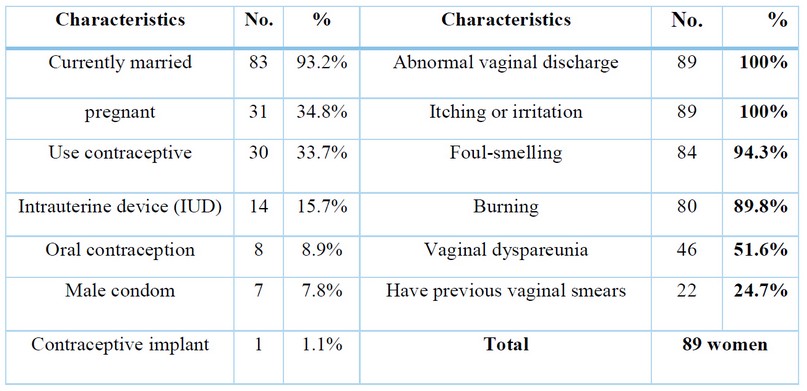
Table 2. Numbers and percentages of patient's data and symptoms
According to Table 2, most (93.2%) of patients in the present study were currently married, and only a few (34.8%) of patients were pregnant; this indicates that the prevalence of AV in non-pregnants was higher than in pregnant women in the present study.
AV Severity percentages among study participates
Wet mount preparation shows the epithelial cells, WBCs, Para basal cells, different bacteria and PMNs in the vaginal swabs under study, which indicate that the patient is suffering from AV infection. AV severity was determined for all patients with positive culture results according to the Donders criteria and scoring. The present study showed that 58.4%, 30.3%, and 11.2% of patients had severe, moderate and light AV, respectively, as shown in (Figure 1).

Figure 1. Aerobic vaginitis severity percentages among study participate
Vaginal pH Test
Different color changes were obtained using the commercial-specific vaginal pH test strips; pH was determined according to the color change in strips after being touched with vaginal discharge and compared with the pH ranges colors on the manufacturer's box. Vaginal pH values and their percentages were obtained, including; pH 5, 5.5, pH 6 and 6.5 in 2%, 10%, 42% and 45% of infected women, respectively.
Identification of bacterial isolates using GP and GN Cards of VITEK 2 Compact Automated System
GP and GN identification cards of VITEK 2 system identified different G+ve and G-ve bacterial isolates with varying values of confidence when 54 isolates (56.8%) showed confidence values 99-96% (excellent identification), 29 isolates (30.5%) showed confidence values 93-95% (perfect identification), 12 isolates (12.6%) showed confidence value (89-92%) good identification value. It is worth mentioning that only 7 isolates were unidentified with both cards and were excluded from this study.
Numbers and percentages of obtained bacterial types
Bacterial growth was observed in 89 (77.3%) of 115 swab samples. Ninety-five bacterial isolates were obtained, including 62 (65.2 %) Gram-positive and 33 (34.7 %) Gram-negative bacteria, as shown in (Table 4). Mixed bacterial infections were noted in 6 (6.7%) cases only. Gram-positive bacteria belong to 5 genera and 13 species, while Gram-negative bacteria belong to 5 genera and 5 species.
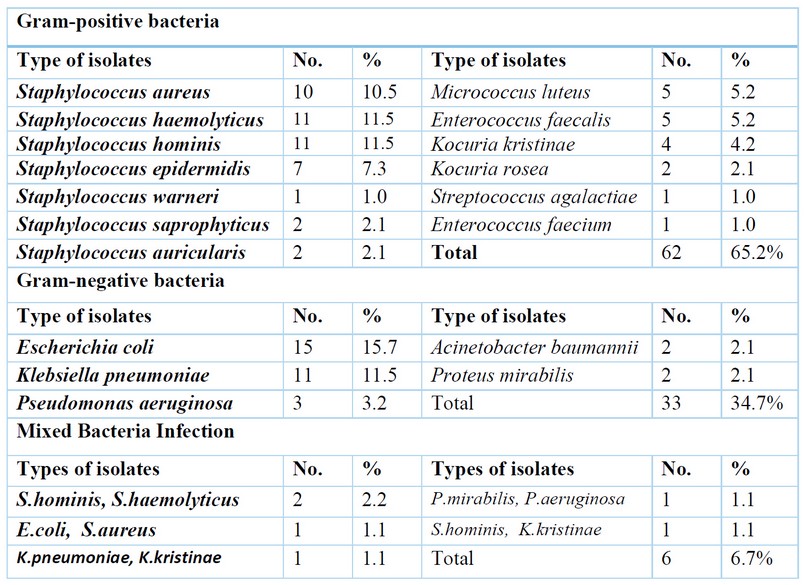
Table 3. Numbers and percentages of identified bacterial types in HVSs
Distribution of AV patients according to age
AV patients were distributed into four age groups: ≤ 20 years in 13 (14.60) cases, (21-30) years in 41 (46.06%) cases, (31-40) years in 24 (26.96) cases and (41-50) years in only 11 (12.35%) case as shown in (Figure 2). It is worth mentioning that most (46. 0%) of the patients belonged to the age group (21-30) years, while only (12.3%) of the patients belonged to the age group (41-50) years.
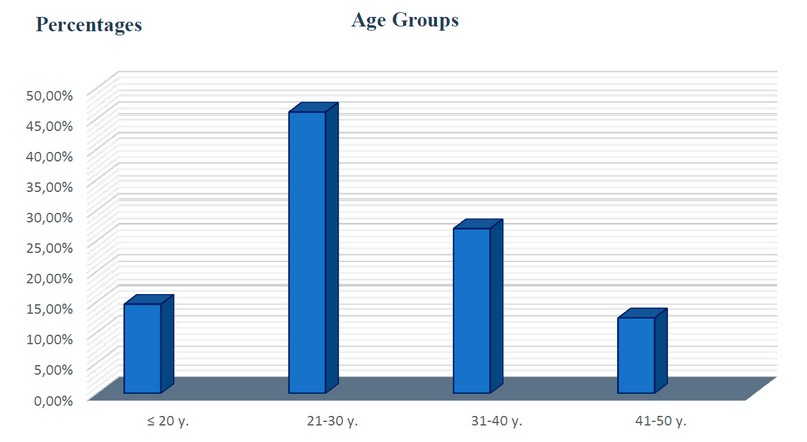
Figure 2. The column chart clarifies the percentage of patients' age groups.
The mean±SE (standard error) and the probability P value of patients' age according to the pathogenic bacterial type were determined as shown in (Table 4); the diversity of AV bacteria according to the age group was significantly different, and the results indicate that the age (p= 0.02, CI 95%) was considered a significant factor in women infected with Micrococcus spp and Enterococcus spp, also in women infected with Staphylococcus spp and P.aeruginosa (p= 0.05, CI 95%). While in women infected with Kocuria spp., E.coli and K.pneumoniae (P value =NS), the age was considered statistically non-significant.

Table 4. Patients' ages mean±SE and p-value according to causative age.
Statistical Analysis
Statistical analysis revealed that few factors were non-significant regardless of bacterial type, other factors were significant with different bacterial types, and some aspects were substantial only with some bacterial types. As shown in (Tables 6 and 7), the infection with Staphylococcus spp was significantly associated with the following clinical symptoms: foul-smelling (p=o.oo8), itching or irritation (p= 0.04), burning (p=0.0001) and vaginal dyspareunia (p=0.01) while pH was significantly non-significant (p=NS), on the other hand, colonization with Staphylococcus spp. were associated considerably with currently married patients (p=0.01) and age (p=0.05) when the age mean ±SE = 29.49±3.5. Another finding was that the infection with Kocuria spp was significantly associated with clinical symptoms, including foul smelling (p=0.008) and burning (p=0.0001). On the other hand, colonization with Kocuria spp. was significantly non-significant with all the patient data in (Table 5) despite that, the patients suffer from many symptoms. Colonization with Micrococcus luteus was significantly associated with all AV symptoms, including; abnormal vaginal discharge (p= 0.0001), foul smelling (p=0.001), itching or irritation (p=0.001), burning (p=0.0001) and vaginal dyspareunia (p=0.01). Also, it was significantly associated with age (p=0.02) and if the patient has previous vaginal smears (p=0.01). According to the statistical analysis, Enterococcus spp. was associated considerably with AV symptoms, including foul smelling (p=0.008), burning (p=0.0001) and vaginal dyspareunia (p=0.005). Also, it was significantly associated with patients' age (p=0.02). Another finding, infection with E.coli and K.pneumoniae were significantly associated with foul smell (p=0.008), itching or irritation (p=0.008) and burning (p=0.001). On the other hand, E.coli was significantly associated with pregnancy (p=0.04), while K.pneumoniae was associated considerably with contraceptive use (p=0.03). Statistical analysis revealed that colonization with P.aeruginosa was significantly associated with foul smelling (p=0.008), itching or irritation (p=0.008) and burning (p=0.001), and vaginal dyspareunia (p=0.01), while according to patients data, P.aeruginosa were associated only with age (p=0.05) and married patients (p=0.001).
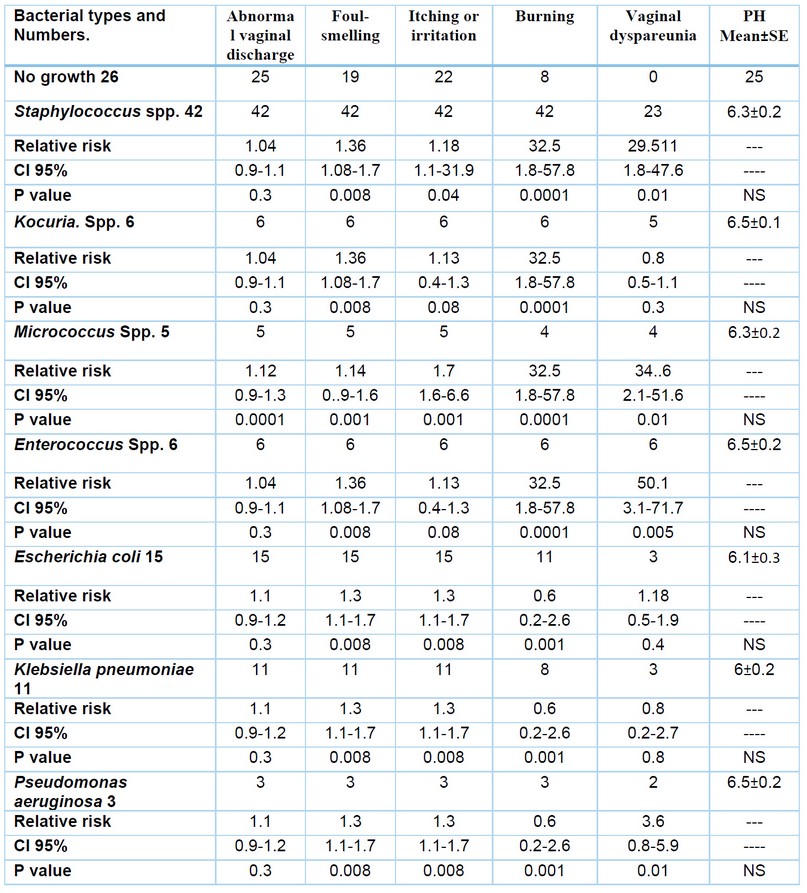
Table 5. The statistical analysis compares relative risk and the P value of bacterial types in the study according to the patient's symptoms.
The relative risk (RR) or risk ratio is the ratio of the probability of an outcome in an exposed group to the possibility of a development in an unexposed group. Together with risk difference and odds ratio, relative risk measures the association between exposure and the outcome.
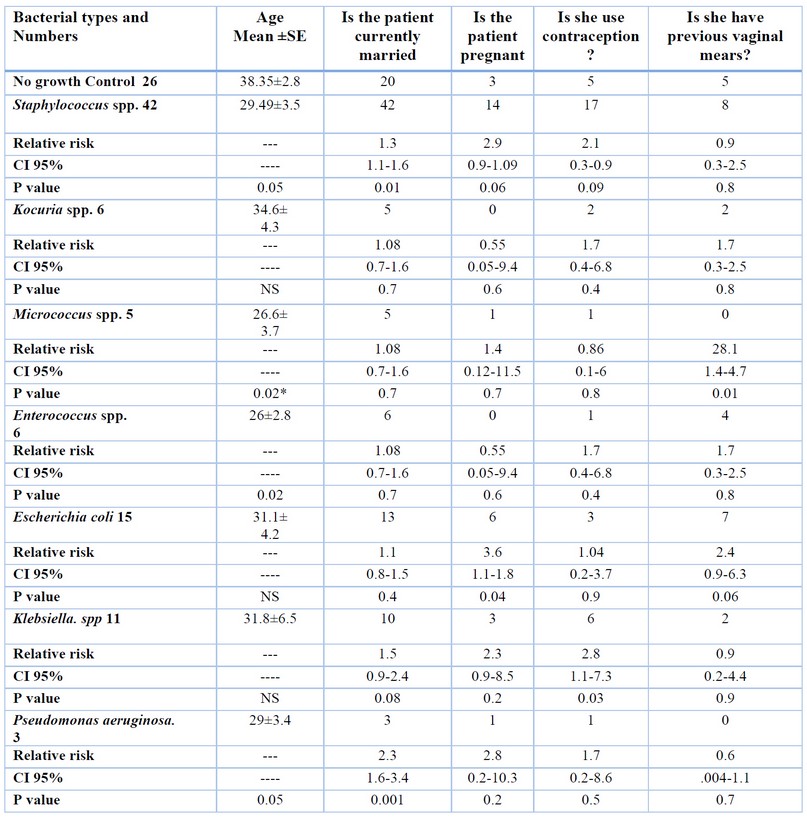
Table 6. Statistical analysis of relative risk and the P value of bacterial types in the study according to patient's data.
DISCUSSION
The present study results showed that Staphylococcus haemolyticus, Staphylococcus aureus and Escherichia coli were the most prevalent bacterial types among AV-infected women. A local study conducted by Jabuk, 18 in Hilla City/ Iraq reported that 64% of women using an intrauterine device (IUD) were infected with aerobic bacteria, including; E.coli, S.aureus, K.pneumoniae and Proteus mirabilis and the most frequent symptom was the presence of abnormal vaginal discharge and the less frequent (18%) symptom was vaginal dyspareunia. Their results agree with the present study results when 100% of patients have abnormal vaginal discharge. In this investigation, abnormal vaginal discharge, foul smelling, itching, burning and vaginal dyspareunia were found to be statistically significant in most patients infected with different obtained bacterial types when p value < 0.05 as mentioned in statistical analysis (Table 5). Another study by Yalew et al. 19 reported that the prevalence of AV in pregnant women was 8.1%. The present study agreed with Mulu et al. 20 when they found that the prevalence of vaginal infection was higher in nonpregnant women than in pregnant women. According to the patient's data, the most frequent factor was marriage (93.2%), and the less was if the patient had previously repeated smears (24.7%), as shown in (Table 2). AV is a form of vaginitis affecting millions of women worldwide that are distinguished from BV; many studies have found that the incidence of AV was approximately 11.77% included, 4.34% in nonpregnant women and 13.08% in pregnant women 21. Another study by Wang et al. 14 found that the AV rate is 15.40% in women who presented with AV symptoms in Southwestern China. Although several researchers have found that AV infection may be companied by other forms of vaginitis BV and candidiasis and present different clinical manifestations, the precise mechanism remains unclear 9, 22. Medium and severe AV in mixed AV infection was more frequent than in simple AV infection in terms of AV score 23.
As reported in the present study, the pH level of the vaginae of AV-infected women was higher than tha5.5-6. It was recognized that the pH level was higher than 4.5 in AV patients because vaginal microflora and lactobacilli levels were lower in comparison 24. In most patients with AV, the vaginal pH was high > 4.5 12. The vaginal pH range (3.8-4.5) indicates healthy women's vaginae. Research conducted by Kaambo et al. 25 agrees with pH test results obtained in this study, when they reported that the vaginal pH in AV-infected women was> 4.5, typically 6.
The most prevalent Gram-positive bacteria were 11(11.5%) S.haemolyticus and 10 (10.5%) S.aureus, while the most prevalent Gram-negative bacteria was E.coli 15 (15.7%); this result was in agreement with previous studies conducted in Iraq when Al-Suadi, 26 found that the most frequent bacterial type was S.aureus in 12 (27.9%) and E.coli in 11 (25.5%) isolated from AV infected women, similar results were obtained by Mohammed et al. 27 when found that the most prevalent bacterial types in AV infected women were S.aureus and E.coli, and similar results were obtained in a study conducted in a foreign country by Wang et al. 14. While the different result was obtained in a study conducted in Iraq by Shaker, 28 when the most frequent bacterial species isolated from HVSs were K.pneumoniae, Streptococcus spp. and E.coli. As shown in (Table 4), mixed infections were noted in 6 (6.7%) cases; similar results were obtained by Mohammed et al. 27 when their AV mixed infection was found in 4 (9.3%) cases only.
As shown in (Figure 2), most (46.06%) of AV-infected women belonged to the age group (21-30) years; this finding is in agreement with a study conducted by Wang et al. 14 when they found that the AV was usually isolated from the sexually active patients age group of 20-30 years, followed by those in the age group of 30-40 years. The highest prevalence in the age groups (21-30) and (31-40) may perhaps be due to these being the highest reproductively active and high sexual exposure groups. A study conducted by Zhang et al. 29 reported that simple AV patients were aged > 50 years, while mixed AV patients were aged 30-40 years and also found that age was a significant factor in AV infections (p=0.003); this result is in agreement with the results of the present study when age is a significant factor in associated with most AV bacterial types.
The differences in bacterial colonization prevalence, types and risk factors associated with AV may be due to several details, including differences in geographical settings, ethnicity, sample size and many other factors 30. AV, without a correct diagnosis, may be diagnosed incorrectly as BV, leading to more severe complications such as Desquamative inflammatory vaginitis, which increases the risk of preterm delivery, chorioamnionitis and many other risk factors 31. In a recent study conducted by Kim et al. 32, they reported that vaginal colonization with S.aureus and E.coli was significantly associated with many pathogens isolated from neonates infected with initial-onset sepsis. The above-reported results (Tables 6 and 7) showed that AV symptoms were significantly associated with different bacterial types. At the same time, according to the patient data, age was the most significant risk factor associated with most bacterial types, followed by married (p=0.01), especially when the causative pathogen was Staphylococcus spp.
CONCLUSION
As concluded, there is a high prevalence of AV among women seeking gynecological care in Baghdad City; AV is a common cause of abnormal vaginal discharge, foul smelling, itching, burning and high pH levels, and the patient may present with all or some of these signs and symptoms. The most prevalent bacterial type in AV patients was Staphylococcus spp. . colonization of different genera and species of Gram-positive and Gram-negative bacteria were significantly associated with two or four tested factors and symptoms except with Kocuria spp. . Only limited studies on AV have been performed in Iraq. So, similar studies must be carried out to improve Iraqi women's health status. On the other hand, healthcare professionals should consider enhancing the education of patients to improve their knowledge of vaginal health and prevent the risk factors of AV.
Acknowledgment. The authors would like to thank Al-Mustansiriyah University/ College of Science/ Department of Biology. Special thanks to all study participants for their cooperation and understanding of this work's importance. Many thanks to the medical staff in Al -Elwea Maternity Hospital and many private gynecology clinics and labs in Baghdad City for presenting the facilities, services and essential support to achieve this work.
Conflicts of Interest. This study's authors declare that they have no conflict of interest.
REFERENCES
1. Donders GG, Vereecken A, Bosmans E, Dekeersmaecker A, Salembier G, Spitz B. Definition of a type of abnormal vaginal flora that is distinct from bacterial vaginosis: aerobic vaginitis. BJOG: an international journal of obstetrics and gynecology. 2002 Jan 1; 109(1):34-43.
2. Valenti P, Rosa L, Capobianco D, Lepanto MS, Schiavi E, Cutone A, Paesano R, Mastromarino P. Role of lactobacilli and lactoferrin in the mucosal cervicovaginal defense. Frontiers in immunology. 2018 Mar 1; 9:376.
3. Aldunate M, Srbinovski D, Hearps AC, Latham CF, Ramsland PA, Gugasyan R, Cone RA, Tachedjian G. Antimicrobial and immune modulatory effects of lactic acid and short chain fatty acids produced by vaginal microbiota associated with eubiosis and bacterial vaginosis. Frontiers in physiology. 2015 Jun 2; 6:164.
4. Han C, Wu W, Fan A, Wang Y, Zhang H, Chu Z, Wang C, Xue F. Diagnostic and therapeutic advancements for aerobic vaginitis. Archives of gynecology and obstetrics. 2015 Feb;291(2):251-7.
5. Donders GG, Bellen G, Grinceviciene S, Ruban K, Vieira-Baptista P. Aerobic vaginitis: no longer a stranger. Research in Microbiology. 2017 Nov 1;168(9-10):845-58.
6. Tao Z, Zhang L, Zhang Q, Lv T, Chen R, Wang L, Huang Z, Hu L, Liao Q. The pathogenesis of streptococcus anginosus in aerobic vaginitis. Infection and Drug Resistance. 2019;12:3745.
7. Donders GG, Larsson PG, Platz-Christensen JJ, Hallen A, van der Meijden W, Wölner-Hanssen P. Variability in diagnosis of clue cells, lactobacillary grading and white blood cells in vaginal wet smears with conventional bright light and phase contrast microscopy. European Journal of Obstetrics & Gynecology and Reproductive Biology. 2009 Jul 1;145(1):109-12.
8. Lamont RF, Taylor‐Robinson D. The role of bacterial vaginosis, aerobic vaginitis, abnormal vaginal flora and the risk of preterm birth. BJOG: An International Journal of Obstetrics & Gynaecology. 2010 Jan; 117(1):119-20.
9. Jahic M, Mulavdic M, Hadzimehmedovic A, Jahic E. Association between aerobic vaginitis, bacterial vaginosis and squamous intraepithelial lesion of low grade. Medical archives. 2013 Mar 1;67(2):94.
10. Vieira-Baptista P, Lima-Silva J, Pinto C, Saldanha C, Beires J, Martinez-de-Oliveira J, Donders G. Bacterial vaginosis, aerobic vaginitis, vaginal inflammation and major Pap smear abnormalities. European journal of clinical microbiology & infectious diseases. 2016 Apr;35(4):657-64.
11. Han C, Li H, Han L, Wang C, Yan Y, Qi W, Fan A, Wang Y, Xue F. Aerobic vaginitis in late pregnancy and outcomes of pregnancy. European Journal of Clinical Microbiology & Infectious Diseases. 2019 Feb; 38(2):233-9.
12. Fan A, Yue Y, Geng N, Zhang H, Wang Y, Xue F. Aerobic vaginitis and mixed infections: comparison of clinical and laboratory findings. Archives of gynecology and obstetrics. 2013 Feb; 287(2):329-35.35.
13. Rumyantseva TA, Bellen G, Savochkina YA, Guschin AE, Donders GG. Diagnosis of aerobic vaginitis by quantitative real-time PCR. Archives of gynecology and obstetrics. 2016 Jul; 294(1):109-14.
14. Wang ZL, Fu LY, Xiong ZA, Qin Q, Yu TH, Wu YT, Hua YY, Zhang YH. Diagnosis and microecological characteristics of aerobic vaginitis in outpatients based on preformed enzymes. Taiwanese Journal of Obstetrics and Gynecology. 2016 Feb 1; 55(1):40-4.
15. Vieira-Baptista P, Bornstein J. Candidiasis, bacterial vaginosis, trichomoniasis and other vaginal conditions affecting the vulva. InVulvar Disease 2019 (pp. 167-205). Springer, Cham.
16. Baron EJ. Specimen collection, transport, and processing: bacteriology. Manual of clinical microbiology. 2015 May 15:270-315.
17. Tille P. Bailey & Scott's diagnostic microbiology-E-Book. Elsevier Health Sciences; 2015.
18. Jabuk SI. Prevalence of aerobic bacterial vaginosis among Intrauterine Contraceptive Device user's women in Hilla city. Journal of Babylon University: Pure and Applied Sciences. Babilônia. 2014 Mar: 2424-31.
19. Yalew GT, Muthupandian S, Hagos K, Negash L, Venkatraman G, Hagos YM, Meles HN, Weldehaweriat HH, Al-Dahmoshi HO, Saki M. Prevalence of bacterial vaginosis and aerobic vaginitis and their associated risk factors among pregnant women from northern Ethiopia: A cross-sectional study. PloS one. 2022 Feb 25; 17(2):e0262692.
20. Mulu W, Yimer M, Zenebe Y, Abera B. Common causes of vaginal infections and antibiotic susceptibility of aerobic bacterial isolates in women of reproductive age attending at Felegehiwot referral Hospital, Ethiopia: a cross sectional study. BMC women's health. 2015 Dec; 15(1):1-9.
21. Dermendjiev T, Pehlivanov B, Hadjieva K, Stanev S. Epidemiological, clinical and microbiological findings in women with aerobic vaginitis. Akusherstvo i Ginekologiia. 2015 Jan 1; 54(9):4-8.
22. Fan AP, Xue FX. Clinical characteristics of aerobic vaginitis and its mixed infections. Zhonghua fu chan ke za zhi. 2010 Dec 1; 45(12):904-8.
23. Sherrard J, Wilson J, Donders G, Mendling W, Jensen JS. 2018 European (IUSTI/WHO) International Union against sexually transmitted infections (IUSTI) World Health Organisation (WHO) guideline on the management of vaginal discharge. International journal of STD & AIDS. 2018 Nov; 29(13):1258-72.
24. Frobenius W, Bogdan C. Diagnostic value of vaginal discharge, wet mount and vaginal pH–an update on the basics of gynecologic infectiology. Geburtshilfe und Frauenheilkunde. 2015 Apr; 75(04):355-66.
25. Kaambo E, Africa C, Chambuso R, Passmore JA. Vaginal microbiomes associated with aerobic vaginitis and bacterial vaginosis. Frontiers in public health. 2018 Mar 26; 6:78.
26. Al-Suadi HH. The bacterial causative agents of aerobic vaginitis in sexually active nonpregnant women and their antibiotic sensitivity pattern. Journal of Wassit for Science & Medicine. 2010; 3(2).
27. Mohammed AB, Hamadamin HA. Antibiotic Sensitivity of High Vaginal Swabs from Asymptomatic Pregnant Women. Diyala Journal of Medicine. 2021 Apr 17; 20(1):70-5.
28. Shaker, H. H. Comparative Study of Local Pathogenic Bacteria in High Vaginal Swabs and Vaginal Swabs in Iraqi Women.Journal of Natural Science Research, 2016; 16 (22), 50-54.
29. Zhang T, Xue Y, Yue T, Xiong L, Wang X, Wang W, Liu Y, An R. Characteristics of aerobic vaginitis among women in Xi'an district: a hospital-based study. BMC Women's Health. 2020 Dec; 20(1):1-7.
30. Tumuhamye J, Steinsland H, Tumwine JK, Namugga O, Mukunya D, Bwanga F, Sommerfelt H, Nankabirwa V. Vaginal colonisation of women in labour with potentially pathogenic bacteria: a cross sectional study at three primary health care facilities in Central Uganda. BMC Infectious Diseases. 2020 Dec; 20(1):1-0.
31. Krauss-Silva L, Almada-Horta A, Alves MB, Camacho KG, Moreira ME, Braga A. Basic vaginal pH, bacterial vaginosis and aerobic vaginitis: prevalence in early pregnancy and risk of spontaneous preterm delivery, a prospective study in a low socioeconomic and multiethnic South American population. BMC Pregnancy and Childbirth. 2014 Dec; 14(1):1-0.
32. Kim JY, Sung JH, Chang KH, Choi SJ, Oh SY, Roh CR, Kim JH. Abnormal vaginal colonization by gram-negative bacteria is significantly higher in pregnancy conceived through infertility treatment compared to natural pregnancy. The Journal of Maternal-Fetal & Neonatal Medicine. 2017 Mar 4; 30(5):556-61.
Received: May 2, 2022 / Accepted: June 12, 2022 / Published:15 November 2022
Citation: Raheem Z K, Said L A. Incidence of symptomatic aerobic vaginitis among some Iraqi women in Baghdad city. Revis Bionatura 2022;7(4) 59. http://dx.doi.org/10.21931/RB/2022.07.04.59
